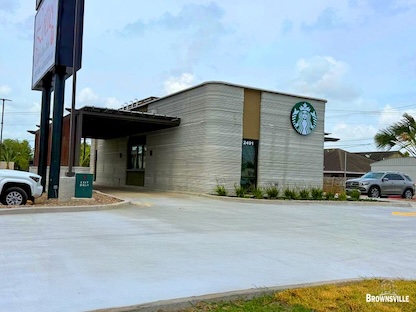Case Engineering provided structural engineering, MEP engineering and drafting on the world’s first 3D concrete printed Starbucks in Brownsville, Texas.
A key milestone in commercial 3D construction for America’s largest coffee company, the innovative project was a collaboration between Starbucks, Germany-based PERI 3D Construction and Denmark-based COBOD International, a global leader in 3D construction printing. St. Louis, MO-based NewGround was the architect on the project.
Opened on May 2, 2025 following a five-month construction schedule, the 1,400-square-foot, grab-n-go Starbucks at 2491 Boca Chica Blvd. features a drive-thru lane and walk-up window. Its 3D printed concrete walls were built using a computer-controlled robotic arm that poured tube-like concrete layers, one on top of another, to form the building’s rectangular footprint.
Case Engineering’s structural team, led by Principal/Senior Structural Engineer Stephen Sacco, P.E., collaborated with NewGround’s architects and the 3D concrete printing company at every step of the way from concept planning through construction to ensure the overall success of the project.
Case’s structural design for the building included perimeter concrete columns cantilevered from the foundations at regular spacings to resist high wind loads at the site, which is located near the Gulf Coast at the U.S.-Mexico border. Concrete columns were also designed to support the exterior 3D printed concrete skin to protect it against horizontal wind loading, while wood trusses were specified for the roof.
Case Structural Engineer Nick McFarland, who helped engineer the Brownsville Starbucks, says utilizing 3D concrete printing to build prototypical, cookie-cutter quick serve restaurants will continue to grow in popularity, with some key structural considerations.
Case’s MEP engineers worked alongside the structural team and COBOD International to design locations for all electrical conduits and domestic water and sanitary piping within the building’s walls prior to the 3D concrete printing process.




